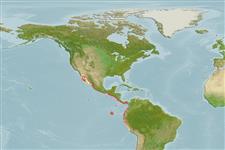Common names from other countries
Environment: milieu / climate zone / depth range / distribution range
Ecologia
marinhas; estuarina; intervalo de profundidade 0 - 142 m (Ref. 96339). Tropical; 31°N - 14°S, 115°W - 76°W (Ref. 189)
Eastern Pacific: San Juanico Bay, northern Gulf of California southward to Callao, Peru and perhaps further south. The record from Santa Margarita Island on the Pacific coast of Baja California, Mexico is based solely on the now lost type of Stolephorus cultratus.
Comprimento de primeira maturação / Tamanho / Peso / Idade
Maturity: Lm 6.0 range ? - ? cm
Max length : 17.0 cm TL macho/indeterminado; (Ref. 96339); common length : 8.0 cm TL macho/indeterminado; (Ref. 55763)
Espinhos dorsais (total): 0; Espinhos anais 0; Raios anais : 20 - 25. Fairly elongate. Snout long, about 3/4 eye diameter or more; maxilla long, tip pointed, reaching almost to gill opening; gill cover canals of panamensis-type; pseudobranch longer than eye diameter, with 30 or more filaments, extending onto inner face of operculum. Anal fin origin under or just behind base of last dorsal fin ray. Silver stripe along flank about eye diameter.
A schooling species occurring in coastal waters, near shores, entering bays and tolerating some lowering of salinity. Spawns throughout the year, but more intensively in the warmer months. The eggs are oval. The most important tuna baitfish in Manta, Ecuador.
Ciclo de vida ou comportamento de acasalamento
Maturidade | Reprodução | Desova | Ovos | Fecundidade | Larvas
Spawns more intensively in the warmer months (Ref. 189). Spawn in school (Ref. 205).
Whitehead, P.J.P., G.J. Nelson and T. Wongratana, 1988. FAO Species Catalogue. Vol. 7. Clupeoid fishes of the world (Suborder Clupeoidei). An annotated and illustrated catalogue of the herrings, sardines, pilchards, sprats, shads, anchovies and wolf-herrings. FAO Fish. Synop. 125(7/2):305-579. Rome: FAO. (Ref. 189)
Status na Lista Vermelha da UICN (Ref. 130435)
CITES (Ref. 128078)
Not Evaluated
Ameaça para os humanos
Harmless
Uso pelos humanos
Pescarias: pouco comercial; isca: usually
Mais informação
ReferênciasAquaculturaPerfil para aquaculturaEstirpesGenéticaElectrophoresesHereditariedadeDoençasProcessamentoConversão de massa
ColaboradoresFotosStamps, Coins Misc.SonsCiguateraVelocidadeTipo de nataçãoÁrea branquialOtólitosCérebrosVisão
Ferramentas
Relatórios especiais
Baixar XML
Fontes da internet
Estimates based on models
Preferred temperature (Ref.
115969): 17.2 - 28.9, mean 25 (based on 142 cells).
Índice de diversidade filogenética (Ref.
82804): PD
50 = 0.5000 [Uniqueness, from 0.5 = low to 2.0 = high].
Bayesian length-weight: a=0.00513 (0.00232 - 0.01135), b=3.14 (2.96 - 3.32), in cm Total Length, based on LWR estimates for this Genus-body shape (Ref.
93245).
Nível Trófico (Ref.
69278): 3.4 ±0.4 se; based on size and trophs of closest relatives
Resiliência (Ref.
120179): Elevada, tempo mínimo de duplicação da população menor que 15 meses (Preliminary K or Fecundity.).
Prior r = 0.99, 95% CL = 0.65 - 1.48, Based on 1 stock assessment.
Fishing Vulnerability (Ref.
59153): Low vulnerability (10 of 100).
